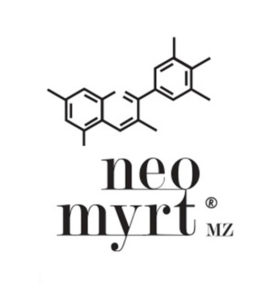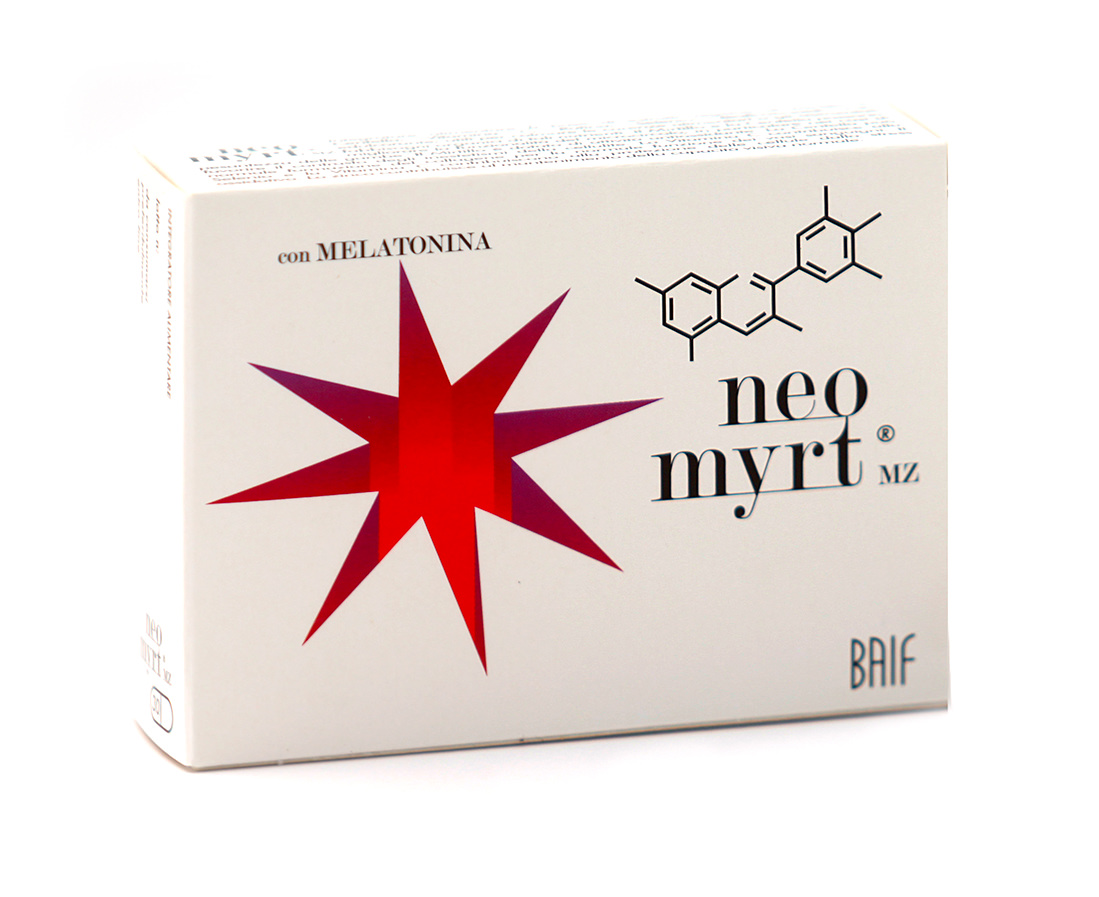

Neomyrt® MZ is a food supplement notified to the Ministry of Health, 30 tablets; based on plant extracts of Blueberry, Centella, Bioflavonoids, Rutin, Vitamin C, Selenium, Zinc and Melatonin, it is useful for filling food shortages or the increased organic needs of these nutrients.
What is Neomyrt® MZ
Neomyrt® MZ is a food supplement notified to the Ministry of Health, 30 tablets; based on plant extracts of Blueberry, Centella, Bioflavonoids, Rutin, Vitamin C, Selenium, Zinc and Melatonin, it is useful for filling food shortages or the increased organic needs of these nutrients.
Indications
Blueberry and Centella can improve the functionality of microcirculation, especially in cases of heaviness in the legs. Blueberry has antioxidant activity. Centella can promote the contrast of cellulite blemishes. Vitamin C contributes to normal collagen formation for the normal function of blood vessels. Selenium and Vitamin C contribute to the protection of cells from oxidative stress. Zinc contributes to the improvement of various functions including the protection of cells from oxidative stress, the normal function of the immune system, the maintenance of normal vision.
Many scientific studies have shown that melatonin, in addition to contributing to the reduction of the time required to fall asleep, is very important for the maintenance of ocular well-being and in particular of the retina.
In fact, the synthesis of melatonin occurs in the retina of most animals as well as in humans. Circadian oscillators that control retinal melatonin synthesis have been identified in the eyes of several animal species. The presence of melatonin receptors is demonstrable by immunocytochemical studies of ocular tissues. These receptors can have different functional roles in different parts of the eye. Since melatonin is a powerful antioxidant molecule, it can be effective in eliminating free radicals generated in eye tissues. With this mechanism, melatonin could protect ocular tissues from disorders such as glaucoma, age-related macular degeneration, retinopathy of premature babies, photokeratitis and cataracts.
Dosage
Average contents for 1 tablet
| Average analysis | VAR% | |
| Blueberry | 150 mg | |
| Bioflavonoids | 85 mg | |
| (intake of hesperidin 51 mg) | ||
| Centella e.s. | 80 mg | |
| Vitamin C | 90 mg | 112* |
| Rutina | 20 mg | |
| Selenium | 20 mcg | 36* |
| Zinc | 10 mg | 100* |
| Melatonin | 1 mg |
(* Valore nutritivo di riferimento)

Additional information
Zinc
Zinc is a microelement, that is, a mineral present in the body in small quantities. In an adult individual there are about 2 grams of it.
Zinc is a component of multiple enzyme complexes that are involved in the metabolism of proteins, lipids, carbohydrates and nucleic acids.
However, it should be noted that our body is able to absorb only a percentage between 20 and 30% of the quantities present in food and it must also be considered that the zinc present in plants is less available and more difficult to absorb.
If we consider that our body needs an average of 12 mg per day and this quantity increases in case of breastfeeding, we can imagine that supplementation is more than appropriate.
Countless scientific works have demonstrated the importance of zinc in the ophthalmological field; in fact Zinc is a trace element that influences cellular metabolism through a variety of mechanisms and plays a fundamental role in maintaining normal ocular function. This element is present in high concentrations in ocular tissues, particularly in the retina and choroid. Zinc deficiency in numerous species has been shown to cause a variety of macroscopic, ultrastructural and electrophysiological ocular manifestations. The physiological functions of zinc have been studied mainly in the retina and in the retinal pigment epithelium, where it is believed that zinc interacts with taurine and vitamin A. modifies the plasma membranes of photoreceptors, regulates the light-rhodopsin reaction, modulates transmission synaptic and acts as an antioxidant. ( B H Grahn et al. “Zinc and the eye” J Am Coll Nutr 2001 Apr;20(2 Suppl):106-18)
Melatonin
Melatonin is a hormone produced by the body and in the vast majority of cases it is associated with sleep; in fact, this hormone “produced” by the pineal gland (an endocrine gland located in the brain, also called epiphysis) which plays an essential role in the physiology of sleep and in the regulation of the sleep-wake cycle (Descartes already called it “the third eye” for its sensitivity to light, for example in lizards).
The production and release of this hormone depends on the conditions of exposure to light, with an increase in the dark and therefore mainly during the night, and a decrease in the hours of light during the day.
The production of melatonin, like most of the substances produced physiologically by our body, decreases with increasing of age and the reduced levels of the hormone released during the night can contribute to the onset of insomnia and / or awakening. early, typical in the elderly.
Since it is the presence of light or rather darkness that regulates its production, it is evident that it also has a different trend according to the seasons, with shorter production periods in summer and longer in winter.
Melatonin also plays a fundamental role in ocular well-being; It has been shown that melatonin, being an effective antioxidant with antinitridergic properties, has a promising role in the treatment and management of glaucoma. (Per O. Lundmark et al. “Melatonin in the eye: implications for glaucoma” Exp Eye Res. 2007 Jun; 84 (6): 1021-30).
As increased free radical generation and impaired nitric oxide (NO) metabolism play a role in the pathogenesis of highly prevalent eye diseases, such as glaucoma and uveitis, the application of melatonin could potentially protect tissues. eyepieces by effectively eliminating free radicals and excessive amounts of NO generated in the glaucomatous or uveitic eye. (Ruth E Rosenstein “Melatonin as a therapeutic tool in ophthalmology: implications for glaucoma and uveitis” J Pineal Res. 2010 Aug; 49 (1): 1-13).
Melatonin, an indoleamine secreted primarily by the pineal gland, is known to modulate a wide range of circadian functions. However, this neurohormone is also synthesized within the eye and acts directly on ocular structures to mediate a variety of physiological processes. This review focuses on the role and therapeutic potential of melatonin in eye diseases. We summarize the data indicating that melatonin can represent a powerful tool to counter ocular dysfunctions such as uveitis, glaucoma, age-related macular degeneration and diabetic retinopathy.
Luca Scuderi et al. Melatonin: ”Implications for Ocular Disease and Therapeutic” Potential Curr Pharm Des. 2019; 25 (39): 4185-4191




